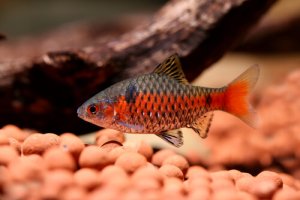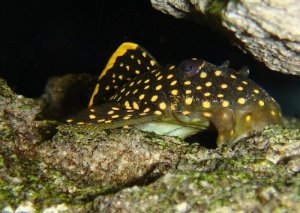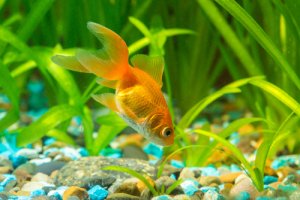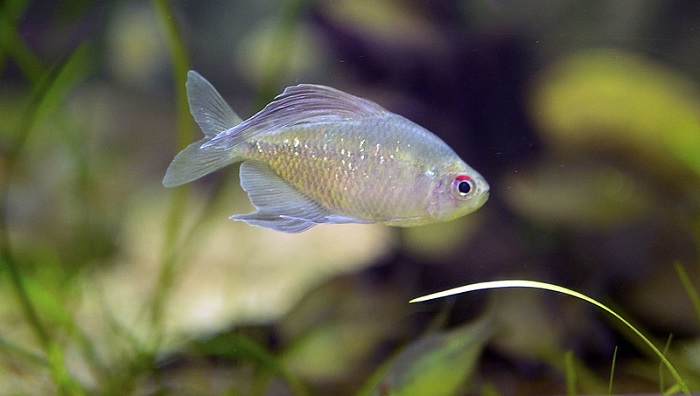
The Diamond Tetra is a popular and striking Freshwater aquarium fish that is easy for beginners to keep and an attractive variety for aquarists. They bring about a certain charm to any aquarium, and because of their friendly and peaceful nature, they are perfect to keep with other peaceful fish species.
If you love shiny iridescent fish with mesmerizing colors, you will love the Diamond Tetra. That said, let me tell you a bit more about the species, and how to create the perfect environment to care for it.
Breed Overview
| Origin | Lakes and Streams in South America |
| Lifespan | 3 – 5 Years |
| Size | 5 – 7cm (2 – 3 inches) |
| Colors | Black, Blue, and Blue Neon |
| Food | Omnivore |
| Tank Size | 20 – 30 Gallons, the minimum for six fish is 15 Gallons |
| Temperament | Peaceful, Shoaling, Social, Active |
| Water Type | Clean Freshwater |
| Water Temperature | 24–28°C (75–82°F) |
| Water pH | 0 – 7.0 |
| Difficulty Level | Beginner Friendly and Easy to Keep and breed |
Species Summary
The Diamond Tetra, scientifically known as the “Moenkhausia pittieri”, or Monk Tetra are peaceful, small freshwater fish, native to the rivers and lakes of South America, especially Lake Valencia, and Venezuela.
They are called Diamond Tetra because of the lustrous, iridescent appeal of their scales when they become mature, which resembles glistening diamonds. The species is from the Characin family with clear differences between adult males and females, which we will look further into.
Color Variations Of The Diamond Tetra
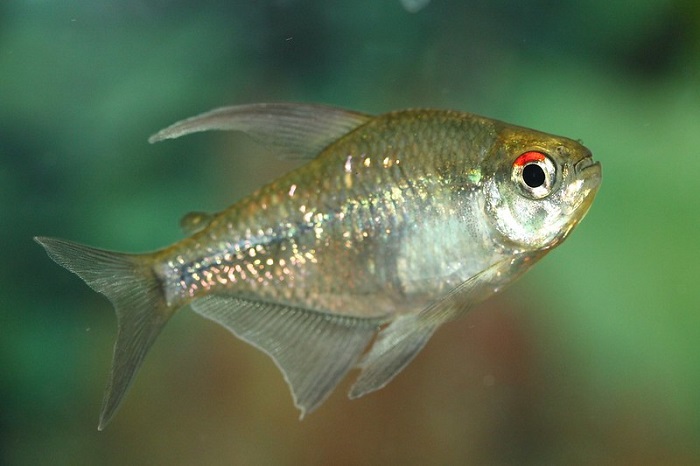
Did you know that the Diamond-like appearance of the Diamond Tetra is because the scales refract light in such a manner that it reflects different colors and shimmers?
Essentially the Diamond Tetra fish is Silver with semi-transparent fins that have a hint of violet in them. When mature the scales become more iridescent and the colors will change depending on the angles that they are viewed at.
The scales can have several different colors such as green, blue, orange, gold, and silver. Similarly, the eye colors of the Diamond Tetra are striking and different, the upper portion of the eye has a subtle red dash.
Male And Female Sexual Dimorphism
You will notice that female Diamond Tetras have a much shorter dorsal fin with a round shape, whereas males have a pointed dorsal fin that is longer. Males tend to be more streamlined and slenderer, while females are slightly larger and bulkier than males. Luckily both males and females boast striking glistening scales, although the females are slightly duller.
Other Colors
Other notable color variations in the Diamond Tetra include:
- The Black Diamond Tetra – A variation of the neon Tetra with shiny black scales, though not related to the Original Diamond Tetra.
- The Blue Diamond Tetra – Not to be confused with the Diamond Head Neon Tetra, it is ideally a Blue color variation of the Diamond Tetra.
- The Blue Diamond Neon Tetra – A variation of the Neon Blue Tetra that does not have the blue neon stripe, but rather blue shimmering scales on its head, and it’s smaller in size.
- The Long Fin Diamond Tetra – Mostly Male Diamond Tetras may be referred to as Long Fin Diamond Tetras because of their longer dorsal fins.
Diamond Tetra Size And Lifespan
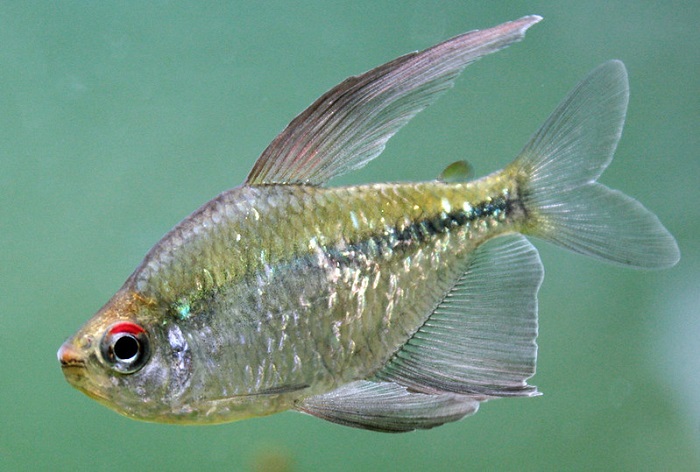
You may have noted that the Diamond Tetra is slightly more bulky than other Tetra species, and larger. Diamond Tetras when mature can reach sizes of between 4.5 – 7cm (2 – 3 inches), and females are larger than males.
They have a lifespan of between 3-5 years. Though they are a smaller species of fish, you need to keep in mind that they have to be kept in a group of six or more fish, mixed with males and females.
Temperament And Behaviour Of Diamond Tetras
Most Tetra species, in general, are very peaceful shoaling fish that can be playful with each other, and that are quite active. When they feel stressed or threatened in any way they may nip at other longer-finned fish, and like other Tetra species, they do not get along with Betta fish species.
Diamond Tetras need companions that are the same species, otherwise, they can quickly become stressed, and slightly nippy towards other fish. They generally enjoy the company of their species much more and tolerate other tank mates.
General Care
As Diamond Tetras are such resilient and friendly fish, they are easy to care for and to match up with the right companions for a communal tank.
Tank Set-Up
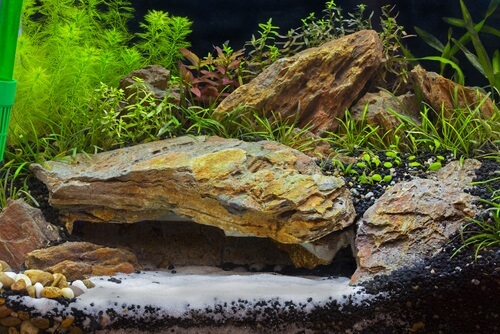
Before we get started with creating an aquarium for your Diamond Tetra, it is always crucial to consider their origin. Diamond Tetras have a natural habitat of very clean, and slow-moving streams and lakes that have much vegetation to make them feel safe. Thus, ideally, we would like to mimic this, to keep them happy and healthy.
- Tank Size – Because you need to keep a group of at least 6 fish a larger tank of around a minimum of 15 gallons, or 20 – 30 gallons is required.
- Water Conditions – Diamond Tetra enjoys soft and slightly acidic water that is clean and clear, with a pH of between 6.0 and 7.0.
- Water Temperatures – They are tropical fish, thriving in warmer water conditions and tropical areas. Thus, temperatures of between 24–28°C (75–82°F) will be ideal.
- Filter – They prefer very clean water, so I highly recommend a strong filter with an adjustable slow current. Mostly Hang on Back Filters are your best option.
- Heater – Unless you live in a very warm area where the temperatures do not drop too low, you will need a heater that is around 150 watts per 30-gallon tank.
- Other Equipment – As you will see when it comes to cleaning and maintenance it is always a good idea to have a siphoning hose, and a tank vacuum or cleaning pad for the sides is an option, but comes in handy. A pH testing kit and thermometer are a necessity though.
- Light – Diamond Tetras like other Tetra species prefer dimed light conditions, and need absolute darkness at night. A low light is ideal with enough plants and dark substrate to give a more darkened environment for them.
Tank Décor
Diamond Tetras enjoy a lushly planted tank with a dark sand or gravel substrate and plenty of hiding spaces. To create a more natural feel, driftwood, rocks, and caves can be used as décor. For Tetras though I recommend Live rather than synthetic plants such as long-stemmed rooted plants, and floating plants.
Amazon Swords, Java Moss, Java Ferns. Hygrophila, Polysperma, Water Wisteria, Duckweed, Amazon Frogbit, water Sprites, and Guppy Grass are all excellent choices. A plus point with Live plants is that they will oxygenate and clean your tank water, and some species may even serve as a tasty snack for your Diamond Tetras, and other community fish.
Introducing Your New Fish
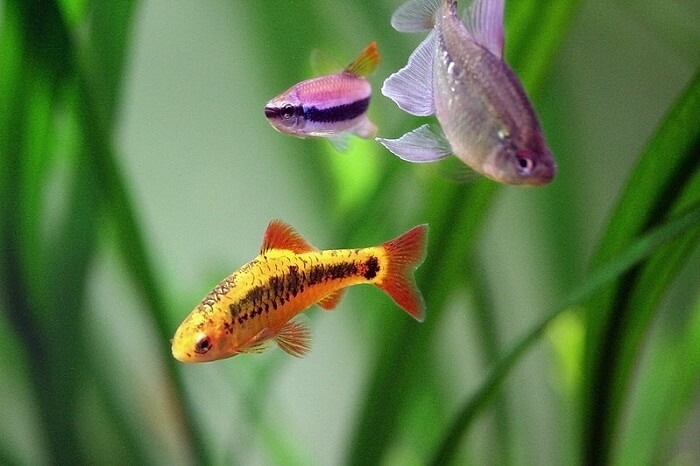
When you are sure that your tank is set up to your liking and your test kit and thermometer readings are all in check, after cycling the tank, you are now ready to add your fish.
Choosing A Healthy Fish
Choose a healthy group of Diamond Tetras from a reputable breeder or pet store. Ensure that the fish is active and swimming, with clear skin and bright eyes. Take note of any damage to the fins and body, patches, white spots, or a swollen belly that may be indicating health issues.
Adding Fish To The Tank
You can follow these steps to properly acclimate your fish before placing them in their new home:
- Let the bag with the fish float on the tank surface for around 20 minutes, to acclimate your fish.
- Replace the water in the bag with that of the tank, a cup at a time, around three to four cups at 10 to 15-minute intervals.
- Release your fish into the tank, and do not allow too much of the water from the bag into the tank, to prevent the ammonia from entering your tank.
Selecting Tank Mates / Companions
Should you wish to keep other fish species with your Diamond Tetras, or to have happy and calm Diamond Tetras, to begin with, I urge you to have a school of at least 6 Diamond Tetras, more if you can, consisting of both males and females.
In a well-planted tank where they are happy and schooling with their kind, Diamond Tetras will easily get along with other peaceful fish that are smaller or similar in size.
You can keep them with other Tetra species, Dwarf, and smaller peaceful Gouramis, Rasboras as well as bottom feeders such as Loaches and Corydoras.
Some other species to consider are;
- White Cloud Minnows
- Cherry Barbs
- Zebra Fish
- Nerite Snails
- Celestial Danios
- Small crabs
- Shrimps
Then again, if you are adding more fish of other species to your tank, you may need to strongly consider a larger tank to accommodate all your fish and to prevent overcrowding, which could cause stress and aggression.
Feeding
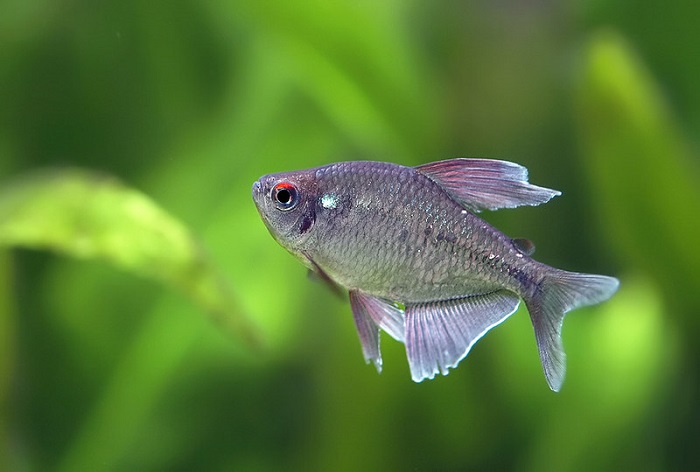
Diamond Tetras are Omnivores requiring a diet with plant and protein-based foods, in-home, Aquariums they will eat mostly quality flakes and pellets as a staple food however vegetables, and meat-based foods can be given as a single meal, or treat;
- Live and Frozen Foods – Brine Shrimp, Daphnia, Mosquito Larvae, Blood Worms, and aquatic larvae.
- Plant Material – Blanched and finely chopped Zucchini, Carrots, Lettuce, Spinach, and Kale.
How To Feed Your Diamond Tetras
Feed your Tetras twice a day in the morning and evening preferably, one meal being a snack such as meat-based or vegetable-based food, and the other fish flakes or pellets. Feed enough for them to finish within a few minutes.
Tank Maintenance
In order to keep your fish healthy and stress-free, they need very clean and clear water parameters.
You will need to do a weekly water change of at least 25% of the tank water, with new fresh conditioned water. Keep the side of the inside and outside of the tank clean, and remove all old food and dead plant matter. Décor and synthetic plants may need to be cleaned occasionally, and you can use a vacuum to clean the gravel in your tank.
Common Pests And Diseases
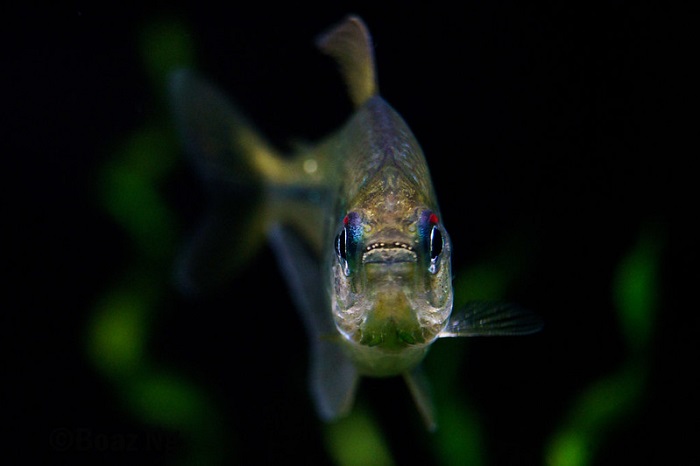
The Diamond Tetra is one of the species that is very resilient and will rarely get ill, given that they have a suitable and clean environment, with healthy tank mates and vegetation.
Most of the time pests and diseases are brought into a clean tank with the addition of a new fish or plant that may be carrying it, unknowingly. In other cases, incorrect water parameters and dirty water will most likely be your culprits for pests and diseases.
Here are a few common health issues sometimes found in Diamond Tetras:
- Flukes – Trematoda Flukes are small worms that may irritate the skin and gills of your fish. They are tiny and cannot be seen with the naked eye, though you may notice redness and irritation on the skin of your fish, and your fish constantly rubbing itself against objects. Most over-the-counter parasitic worm treatments can be used, and you may have to quarantine sick fish.
- Ichthyobodo – Also referred to as Ich, it is a Protozoan parasite that causes white spots on your fish, caused by infection, stress, and an unsanitary tank environment. Improving water conditions, quarantining your affected fish, and increasing aquarium salts are your best options for a cure that may take a week or so.
- General Bacterial Infections – Bacterial Infections can cause issues such as Fin Rot, where the fin and skin become infected, Dropsy, where the swim bladder is infected, or an eye infection. Most bacterial infections are treated with an antibiotic from a veterinarian, and by moving your fish to a quarantine tank with optimal water conditions that are slightly warmer.
How To Breed Your Fish
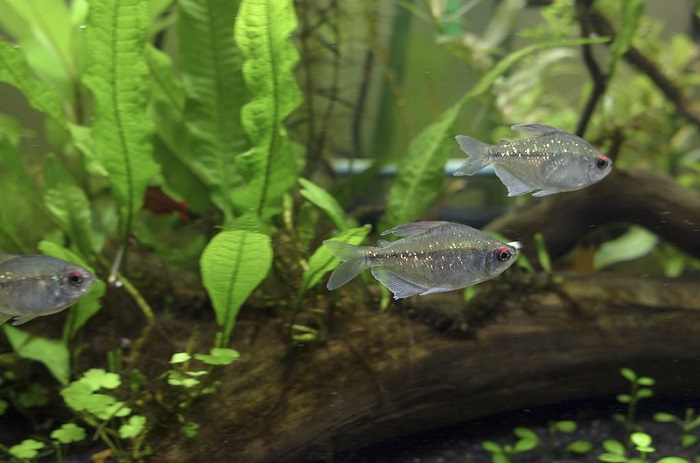
Diamond Tetras are egg scatterers that provide no parental care, yet they are easy to breed, and all you need is a separate tank. They are known as prolific breeders because of the large number of eggs that they lay. A single Diamond Tetra female can lay between 350 – 600 eggs of which at least half will be fertilized.
- Breeding Tank – Create a separate tank of around 20 to 30 gallons with plenty of plants that have fine leaves, and provide good shading. Adjust the water temperatures to slightly higher, around two or three degrees, and ensure that the water is clear with good parameters.
- Spawning – Tetras prefer one female per male, and you can keep them in male and female groups to spawn if needed. They will spawn early in the morning laying eggs all over, while the male fertilizes them.
- Egg and Fry Care – After spawning the parents must be removed as they tend to eat their eggs. The fry should hatch within 24 to 36 hours, and take around 2 to 3 days before they become independent in which case you can feed them baby brine infusoria. As the fry gets older you may need to rehome them or move them to a larger tank.
Final Thoughts
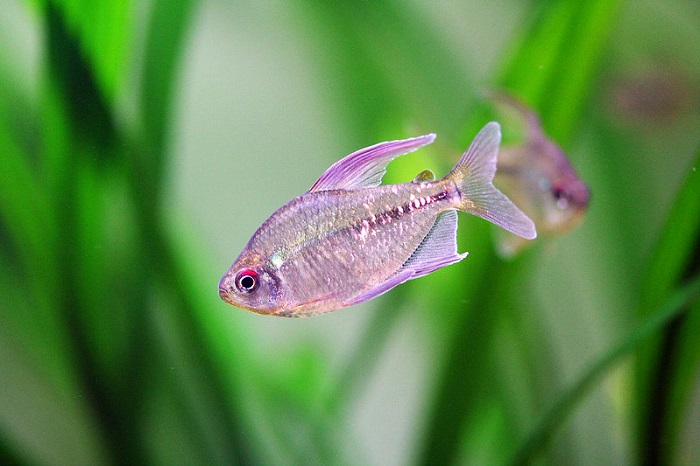
The Diamond Tetra species is one of the most spectacular of the Tetra species, with its lustrous colors that shimmer, and change as they swim actively. They are easy to care for and a joy to have in any communal tank, with the right water conditions.
If you wish to breed them, they are just as easy to breed, and you may soon have more tiny little ‘Diamonds’ swimming around than you can handle.


